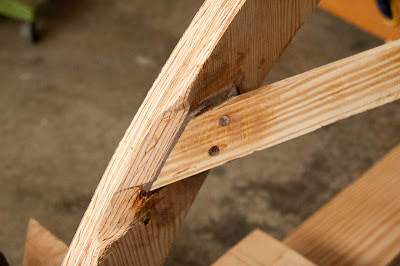I decided that it would be a good idea to re-build and reinforce that part of my construction form that supports the breasthook. I've always felt that this area was the weakest point in my construction form anyway.
The first step was to completely remove this part of the form. This was relatively easy, as all I had to do was un-screw the base board from the forward support structure, and then just kick the whole assembly out from under the stem.
The next step was to remove the blocking assembly from the forward part of the base board. I kept the blocking assembly itself intact, as the height was correct. The plan was to simply replace it onto the new base board.
For the new base board, I'd purchased a new 1" x 6" x 10' board. This was so it would be long enough to be fastened to two of the three support structures of the building form. I measured and marked the centerline on this board, the blocking assembly, and everything else. Though I admittedly started my whole boatbuilding quest with little-to-no experience with boats, I've learned that the centerline is extremely important. It is the crucial reference point for the symmetry of the boat.
With this done, I attached the blocking assembly to the forward part of the base board. Since there are now so many parts of the boat frame fastened together, I could not reach to measure and mark the centerline on the inner support structures of the form. So, I measured and cut 1x6 spacers that would correctly center the base board & used these to align the base board with the construction form. Worked like a charm. The centerline of the blocking assembly was extremely close to the centerline on the breasthook. I guess my initial alignment was better than I'd thought.
After screwing the base board to the construction form's support structures, I next added a brace from the front of the construction form to the base board. Again, this was all based on the measured centerline. The brace is made from two angle-cut 2x4s screwed onto blocking on both the construction form and the base board.
The whole thing seems pretty solid now.
I'll just have to be certain to remove that forward bracing before all the planking goes on. Otherwise, I won't be able to remove the boat from the form.
 |
| The new base board & forward bracing. |
 |
| Frame screwed to construction form with 3" wood screws & plywood washers. |
After installing the new base board assembly, I screwed the forward
frame onto the construction form itself. I probably should've done this a
long time ago. Up until this point, all the frames had been firmly
clamped into position. However, I found out the hard way that they would still move. As with the forward bracing, these screws must be
removed before all the planking goes on.























